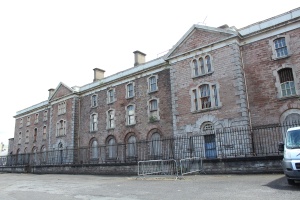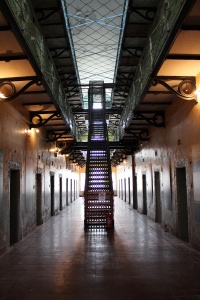Story and photos by
Kelly O’Brien
ARMAGH, Northern Ireland – On an unusually warm day in this city, the bitter chill inside the Armagh Gaol is a shock. The information pamphlets inside the front door are damp from the dense moisture in the air.
Paint is peeling from every wall, there are holes in the ceiling, and most windows in the building are broken.
Standing inside, it’s hard to believe the plans to turn it into a luxury hotel.
The Armagh Gaol – pronounced “jail,” since this is the old English spelling of the word – is infamous for its foul history. But now the city has ambitious plans to turn it into a boutique hotel, as both a tourist attraction and a chance to revamp the neglected part of the city surrounding the jail.
While the inside of the building is in shambles, and the outside in danger of following suit, city council officials are confident that they can transform it into something that will boost the economy of the city.
The council’s communications officer, Claire Shields, says that the public response to the plans has been positive overall.
While the interior of the building may become unrecognizable, its connection with parts of Northern Ireland’s difficult history is hard to ignore.
***
The jail, open from the late 1700s until 1986, has a lengthy controversial history, stretching from the time of the Irish famine in the 1840s to the Troubles, which seized Northern Ireland from 1968 to 1998.
During the famine, the narrow cells of the jail, designed to hold two prisoners each, at times would be forced to hold eight to 10 men. Many of these prisoners were caught stealing for their families, or committing petty crimes to be guaranteed some food in the jail.
This overcrowding created conditions so poor that at the height of the famine dozens of prisoners died each week.
The jail became women-only in 1920. During most of the Troubles, the majority of inmates were female political prisoners. Many of these women were members of the IRA, the Irish Republican Army, and were engaged in various protests, such as hunger strikes.
In 1980, a “dirty” or “no wash” protest began inside the prison, inspired by the male prisoners of Long Kesh – commonly known as “The H Blocks.” The Armagh protest was sparked Feb. 7, 1980, when prisoner treatment hit an all-time low.
Drawn out of their cells with the promise of a good meal, the wardens searched their cells. Then the women themselves were searched, beaten, and punished for any resistance.
After the cell raid, the women were also forbidden from using the toilets, and from emptying the chamber pots they were then forced to use. The 13-month-long dirty protest began here.
Left with overflowing chamber pots, the women began to smear their excrement and menstrual blood on their cell walls, which some casually referred to as “decorating the walls.” They also refused to bathe or change their sheets.
The mere mention of menstruation could be frowned upon in the conservative society these women lived in, so the new openness about it was shocking to those who learned about the protest.
***
Today, despite the nauseating image, many of the people of Armagh are unaware of this history. This may be because of a widely admitted tendency – an unwillingness to bring up darker periods of Northern Ireland’s history.
“It’s bad vibes for a whole lot of people, you know,” said Dougie Somerville, a member of the First Armagh Presbyterian Church, and life-long resident of the city. “It’s just a bad time of our history.”
Irish Republicans, associated with their wish to unite Ireland as a whole, independent republic, tended to see IRA inmates as “political prisoners.” On the other end, “Unionists,” who support Northern Ireland’s part in the United Kingdom, viewed the same inmates as terrorists.
“They just can’t agree on it,” Somerville said. “The political aspect of it… They don’t agree so they don’t engage.”
However, he said there is an increasing number of people in the middle who don’t view the history as a problem in the present.
This middle group isn’t talking about it because these are not issues anymore, he said. “There’s a middle ground who have moved on.”
City officials stress that while the building itself will be transformed, they will also do what they can to preserve the jail’s history and structure.
“That’s one of the things that they want to be able to ensure, that they keep the heritage of the building,” said city council spokeswoman Shields.
The plan calls for a heritage center in the hotel, where part of the prison to be left in its current state to preserve some of the history intact.
The public appears to be on board with the renovations. City council has held a number of public consultations about the project over the past few years to let local residents voice any concerns they may have.
Shields said the public consultations drew “a significant amount of interest.”
The building, which has been progressively crumbling over the years, serves almost no purpose in the city since the jail closed in 1986.
This month, August, the city council will be offering guided tours inside the jail every Friday and Saturday until Sept. 13, for a small ticket price. Meanwhile, however, the jail slowly falls apart, and this is not an appealing option for anyone.
You can see the deterioration as you walk around it, says local resident Somerville. “It got left behind after the Troubles, you know. It took a terrible pasting during the Troubles, and it didn’t really get the investment then after that.”
The hope is that revamping the building and giving it a new purpose will increase tourism, create more jobs, and boost the economy.
***
Unfortunately, a recent roadblock may halt or end this project.
While it has been discussed and planned for the past decade, The Osborne Group, the developer, is now threatening to pull its £11 million contribution ($18.6 million USD) if other contributors don’t increase what they’re offering. The Osborne Group had increased its own funding from £8 million.
Now the developer is asking Stormont, the national government in Belfast, to increase its funding from £6 million to £10 million. In mid-July, The Osborne Group announced that unless Stormont makes this commitment by the end of September, it will pull its £11 million out altogether.
In addition, the Heritage Lottery Fund, which has offered £2 million, will also pull its funding unless the entire £25 million budget is met.
After such a long buildup for this project, such a sudden end may leave the city reeling. What will be left of the building if there is no funding?
Aidan Mallon, the property services manager for Armagh city council, believes that something has to be done as soon as possible.
While the deterioration inside has less of an impact since the entire building will be gutted if construction starts, it’s the outside that he’s worried about.
If the outside stonework – made of soft, Armagh stone – sustains more damage, the budget of the entire project would have to rise.
“My personal opinion is it needs to be done very, very soon,” he said. “I can see coming in here, year and year, the deterioration of the building and that it needs attention before it starts imploding on itself.”
SOUNDSLIDE WITH PHOTOS OF THE JAIL AND AUDIO ‘TOUR’ BY AIDON MALLON





Where’s the Soundslide? It seems to be down.